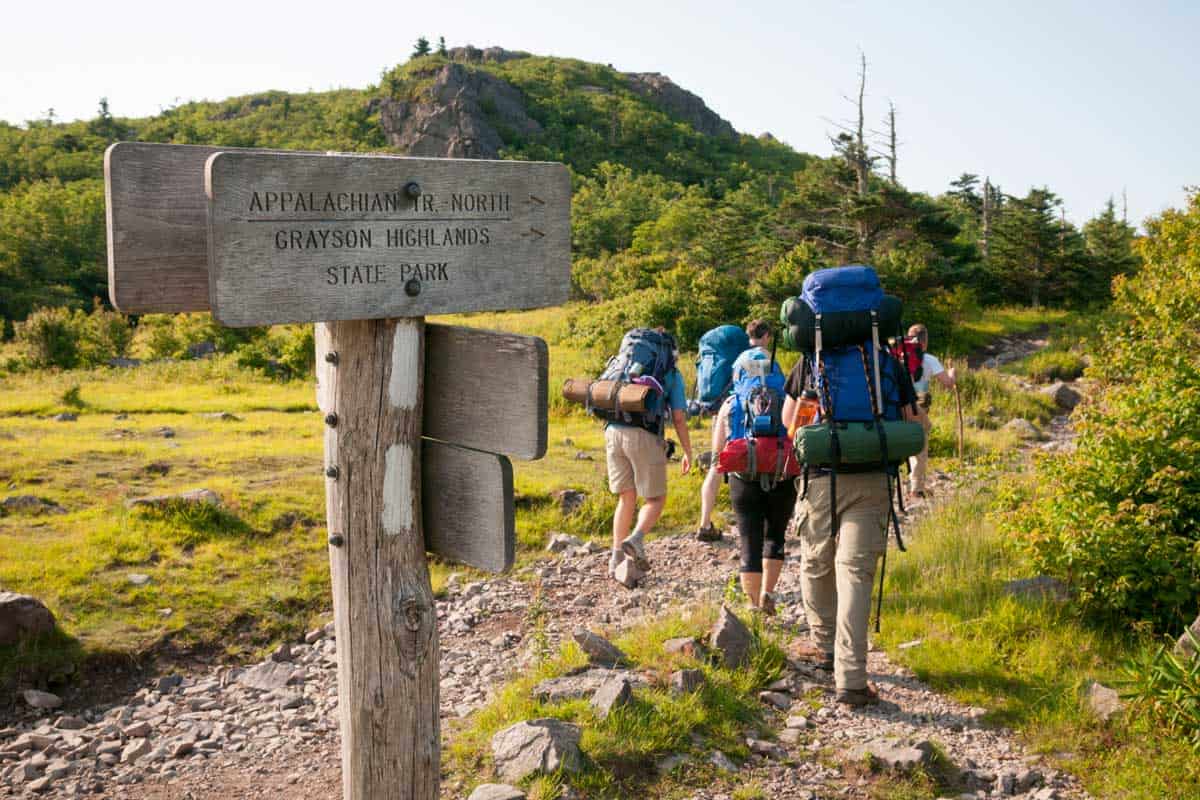Whether you are new to the joys and trials of hiking, or a seasoned expert, you have most likely heard of the Appalachian Trail. Known for its majestic views and historical byways, the Appalachian Trail shows up on many hiker's bucket lists. If it is on yours, then you need to know just how difficult hiking this trail is. We have dug deep to gather all the information you need to know before setting out on your next adventure!
Boasting 2193 miles of rugged beauty, hiking the Appalachian Trail is definitely not a walk in the park. Thru-hiking the entire trail is challenging, even for experienced hikers. It requires substantial planning, training, time, and money to hike the entire trail. However, sections of the trail are much easier for beginning hikers who are looking for a day trip or for those who want to experience the trail a section at a time over several years.
Hiking the Appalachian Trail in-whole or in-part is an adventure of a lifetime! Keep reading to learn more about the trail itself, how to prepare, and the costs involved.

Hiking the Appalachian Trail
The Appalachian Trail is approximately 2193 miles in length as it meanders through the length of the Appalachian Mountains, crossing through 14 states from Georgia to Maine. It is the longest hiking-only foot trail in the world! It has a variety of terrain, from flat bottom-land to treacherous mountains. Completing the entire trail is equivalent to climbing Mt. Everest 16 times.
Some sections are easier to hike than others, like the Shenandoah Valley in Virginia, which follows many ridge tops and has more farms and flat land than some of the other sections. Like the Mahoosuc Notch in Maine, other parts are extremely difficult even for experienced hikers and not to be taken on lightly.
Thru-hiking the Appalachian Trail successfully requires a great deal of time, preparation, training, and money.
How Long Does the Appalachian Trail Take?
Due to the sheer length of this trail, completing it is a serious investment of time. It takes the average hiker 5-7 months to finish, depending on their speed, and how many and the duration of their stops along the way. It is not feasible for most of us to step away from our jobs and day-to-day lives for such a long period of time, so a lot of people choose to hike the entirety of the trail in more manageable sections over the course of several years.
How Many Miles A Day Should You Walk On the Appalachian Trail?
It is usual to start slow at around 8 miles per day until your body gets used to the exertion, then steadily increases to 12 to 16 miles per day.
Can a Beginner Hike the Appalachian Trail?
While parts of the Appalachian Trail are challenging, beginners can complete this trail, as long as they plan and prepare properly. Before embarking on your trek, make sure that you do your research and follow the tips below for the best chance at success.
If you don't want to jump right off the deep end, try flip-flopping and start at one of the easier sections of the trail, like the Shenandoah National Park in Virginia. It is 104 miles of beautiful countryside, a lot of which winds along the Blue Ridge Mountain ridge tops and rarely exceeds climbs of more than 1000 feet. It takes around 10 days to complete, which will give you good insight if committing to the rest of the trip is for you!
What is the Hardest Part of the Appalachian Trail?
The votes are in, and most hikers say that the Southern Maine portion of the trail is the most difficult but often the most rewarding! The hardest part is the Mahoosuc Notch, located in the Mahoosuc Range of the White Mountains. It is covered with boulders that have to be maneuvered around, either climbed over or under, or squeezed through. At times, it is nothing more than a narrow passageway between rocks, and hikers must be prepared to unstrap their packs and crawl or climb across wet moss and stone to get through. It is commonly referred to as "the hardest mile" in the Trail.
Preparation
Once you have determined how much time you have to commit to your adventure, you can start planning.
Your first step is to research, research, research! Learn about each section of the trail by reading informational websites and travel books, first-hand accounts, visit hiking forums, like trailforums.com. You need to know about the terrain, potential issues, arranging supply stops, drops, and deliveries, the best places to stay when in town, campsites and shelter locations, what equipment you need for each portion of the trek depending on your travel time of year, and fees and regulations, as they can vary in different areas.
Can I Camp Anywhere on the Appalachian Trail?
Knowing where you can or can't camp in different areas of the trail is very important. While there are approximately 250 shelters along the trail that are available to hiker son a first-come, first-serve basis, you also need to know where you are permitted to camp if one is not.
There are designated campsites along the length of the trail as well, usually near a water source. On some parts of the trail, dispersed camping is permitted. This is where you can choose your own campsites, but it is preferred that you use the designated sites to minimize the impact on the environment. It is up to you to make sure that you are in an area that permits dispersed camping and pay any fees for campsites, etc. that may be required in certain parks.
When pitching a tent, you should always try to find a place on a rock or already bare, instead of an area covered in greenery. If you build a fire, make sure that you follow all guidelines, and don't forget to remove all trace of your being there, including all food scraps and any trash.
Working with the Weather
The time that you start your hike is very important due to taking advantage of optimal weather conditions. Many people chose to start at the Georgia end of the trail in March, as the weather is much more agreeable than Maine in winter. The Maine portion of the trail is also much more challenging, even in good weather.
Some hikers choose to start somewhere in the middle of the trail, completing one portion, then coming back to finish the other part. This helps to limit the number of hikers all starting at the same time from the same place, which can be detrimental to the environment, not to mention frustrating if your goal is to enjoy the serenity of nature away from people.
Supply Planning
Determining where you can send care packages ahead on the trail, so you do not have to carry everything is crucial. For most sections, you only need to carry 3 to 5 days worth of supplies, as the trail passes near or through towns frequently, allowing you to restock as needed. Keep in mind that not all locations may have all the supplies in stock that you need at the exact time that you are there, especially during peak season.
In this case, some supplies may be easier to purchase ahead of time and shipped ahead to specific locations along the way. This is a great way to make sure that you have everything you need, especially if you have special dietary or medical needs. Post offices will often hold packages for hikers, and even some businesses, especially if you plan on using their services. Researching this information and calling ahead to confirm that you can do this is ideal, then you will be able to pick up or drop off items when you arrive.
Equipment
Ensuring that you have the proper gear is critical, whether you are just day-hiking or planning for the long-haul. A few of the items that you will need are:
Hiking Boots
Good quality hiking boots are imperative whether you are hiking for two hours or two months. Choose a waterproof pair so you can hike through standing water instead of going off-trail to keep your feet dry. Going off-trail can widen the trail and cause damage to the natural environment.
Click here to see these on Amazon.
Backpack
A good, lightweight, and waterproof backpack is also high on the list of requirements. Take the time to research which one will best meet your needs depending on your plans.
Click here to see this on Amazon.
Tent
If you are going out for more than a day, then you need a lightweight, weatherproof tent in your pack.
Click here to see this on Amazon.
First Aid Kit
A small first aid kit is always important to have with you. You should also make sure to carry insect repellant and sunscreen.
Training
Hiking the Appalachian Trail is physically and mentally challenging, so it makes sense that you want to be in the best physical and mental condition possible.
Mental Preparation
Long grueling days, sometimes in inclement weather, across difficult terrain can really get to a person, so having the right mindset from the outset can make the difference between completing your goals or not. Practicing mindfulness and meditation skills can help you stay in the moment and redirect your focus to a more positive state. Problem-solving techniques and skills can also benefit hikers in a big way by helping you to come up with creative solutions when you have limited resources.
Physical Preparation
It goes without saying that being physically capable of taking on such a challenging endeavor is crucial. Not taking the time to physically train properly can result in serious injury. Experts recommend the following: Yoga for flexibility, Cardio and strength training for endurance, and even rock-climbing! The most important training that you can do before a big hike is more hiking!
How Much Does it Cost to Hike the Appalachian Trail?

Another important consideration is cost.
Some costs are relatively fixed, like that for equipment, while others can vary depending on your trip duration.
Fixed Costs
Some costs will not change for most trips, as you will need hiking boots and a tent whether you plan on hiking for three days or three months. The estimated costs for these items are between $700-$5000 depending on what you decide you need and the quality and costs of these items.
Variable Costs
The longer that you plan on being on the trail, the more it is going to cost. It is estimated that it costs approximately $1000 per month to hike the Appalachian Trail. This includes trail supplies, shipping for mail drops, visits to towns where you might spend a night or two, and park fees. Obviously, if you minimize the time you spend in town, this cost will decrease, while if you plan on taking good long breaks along the way, your costs will increase exponentially. It is ideal, though, to plan some scheduled breaks along the way to get a hot shower, sleep in a soft bed, and get a few good meals. It will boost your morale as you go along, as well as keep hiker's hunger at bay!
Conclusion
As you can see, hiking the Appalachian trail is a challenge, whether you are a novice or a seasoned pro! But with the proper planning and preparation, you can cross this holy grail of trails off your bucket list!
To learn more about hiking, check out these other posts from Fitseer.com!







![Read more about the article Bowling Ball Finger Inserts Or Not? [Pros And Cons Discussed]](https://fitseer.com/wp-content/uploads/2022/05/Close-up-hand-of-woman-is-holding-ball-against-bowling-alley.-500x333.jpg)


